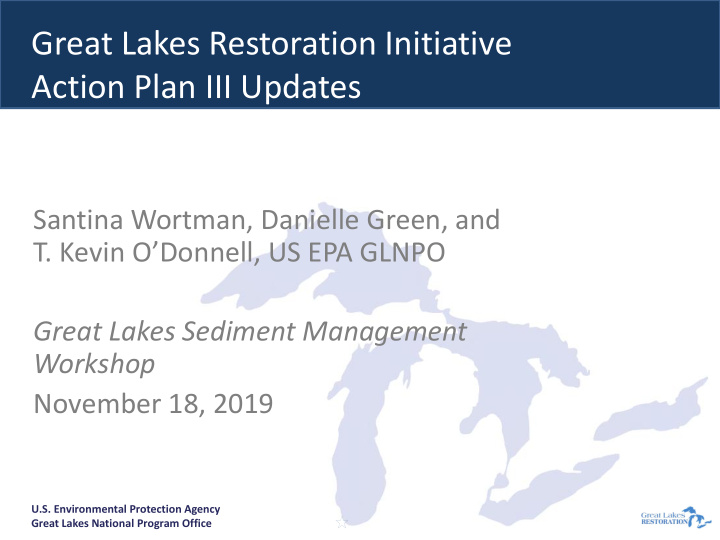



Great Lakes Restoration Initiative Action Plan III Updates Santina Wortman, Danielle Green, and T. Kevin O’Donnell, US EPA GLNPO Great Lakes Sediment Management Workshop November 18, 2019 U.S. Environmental Protection Agency Great Lakes National Program Office
GLRI is a true partnership! • EPA + 15 federal agencies • Our key partners are states, tribes, and local governments, as well as NGOs, academia and industry U.S. Environmental Protection Agency Great Lakes National Program Office
5 Year Action Plans Action Plan I: FY2010-2014 Action Plan II: FY2015-2019 Action Plan III: FY2020-2024 U.S. Environmental Protection Agency Great Lakes National Program Office
GLRI has 5 Focus Areas 1) Toxic Substances and Areas of Concern 2) Invasive Species 3) Nonpoint Source Pollution Impacts onNearshore Health 4) Habitats and Species 5) Foundations for Future Restoration Actions U.S. Environmental Protection Agency Great Lakes National Program Office
> 4,850 Projects U.S. Environmental Protection Agency Great Lakes National Program Office
• $35 M spent annually on HABs prevention & research – About half ($17.5 M) in Lake Erie U.S. Environmental Protection Agency Great Lakes National Program Office
Focus Area 3: Nonpoint Source Pollution Impacts on Nearshore Health Objectives: 3.1. Reduce nutrient loads from agricultural watersheds. 3.2. Reduce untreated stormwater runoff. 3.3. Improve effectiveness of nonpoint source control and (NEW) refine management efforts. On farms or in urban areas, the goal is the same: Slow it down, soak it up, filter pollutants U.S. Environmental Protection Agency Great Lakes National Program Office
Accomplishments to date U.S. Environmental Protection Agency Great Lakes National Program Office
Edge-of-Field Effectiveness Monitoring U.S. Environmental Protection Agency Great Lakes National Program Office
U.S. Environmental Protection Agency Great Lakes National Program Office
Tools & Technology • HABs forecasting models • Runoff Risk Advisory Tool • Tipping Points Planner U.S. Environmental Protection Agency Great Lakes National Program Office
What’s new in FA3 under Action Plan III? • Ambitious Targets for primary measures (3.1.1 phosphorus & 3.2.1 stormwater) • Outcome-based metrics – New measure 3.1.2 for increasing adoption of nutrient management – New measure 3.2.2 for streambank restoration • New Objective 3.3 evaluating effectiveness of nonpoint source control efforts U.S. Environmental Protection Agency Great Lakes National Program Office
3.1 Priorities ➢ Emphasize work in the priority watersheds for P reduction ➢ For Nutrient Management Implement systems of conservation practices Expand outreach & education ➢ Leverage NRCS conservation program partners & small grant programs to: ❖ Encourage adoption of innovative technologies and performance-based approaches to reduce nutrient runoff and soil losses; ❖ Promote practices that slow down and filter agricultural stormwater runoff, (two-stage ditches, wetlands, and saturated buffers); and ❖ Expand demonstration farms U.S. Environmental Protection Agency Great Lakes National Program Office
3.2 Priorities • Strategically target green infrastructure • Promote new approaches & partnerships • Protect and restore streambanks and riparian zones U.S. Environmental Protection Agency Great Lakes National Program Office
3.3 Science Priorities 1. Continue the BMP monitoring studies underway, and establish new sites to test the effectiveness of innovative practices; 2. Use the tools and lessons learned under Action Plan II to optimize outcomes of nutrient and stormwater reduction projects; and 3. Promote development of new strategies for nonpoint source control, such as market-based approaches, nutrient recovery, and manure transformation technologies. U.S. Environmental Protection Agency Great Lakes National Program Office
Focus Area 4: Key Differences for Coastal Systems Between Action Plan II & III • APIII: Encourage Larger and • APII: Set Aggressive Coastal Sustainable Projects Wetland Targets , Raise Through Systematic Attention to Issue, Make a Approaches Significant Impact to the Resource U.S. Environmental Protection Agency Great Lakes National Program Office
Focus Area 4: Continue to Recognize Importance of Coastal Wetlands Open Embayments Barrier-Beaches Drowned River Mouths Protected Embayments U.S. Environmental Protection Agency Great Lakes National Program Office Photo from Minc and Albert (2000) and taken by Ted Cline (1996)
Maintain Robust Monitoring of Coastal Wetlands (2011-2019) U.S. Environmental Protection Agency Great Lakes National Program Office 18
Great Lakes Coastal Wetland Indicators of Health – Invertebrates – Fish – Plants – Birds – Amphibians – Chemical/Physical U.S. Environmental Protection Agency Great Lakes National Program Office
Focus Area 4: Provide Local Partners with Project-Scale Restoration and Monitoring Information • https://www.epa.gov/ great-lakes-monitoring • Consider if a an existing effort deserves attention (e.g., Phase II) before a new project start is considered 20 U.S. Environmental Protection Agency Great Lakes National Program Office
New GLRI Focus Area 4 Projects Will Increasingly Be Viewed in a Regional Context
Additional Considerations for Focus Area 4 Coastal Projects • Consider a pragmatic approach to restoration which considers coastal processes • Are your expected project outcomes appropriate for the characteristics of the associated coastal system? U.S. Environmental Protection Agency Great Lakes National Program Office
Focus Area 4: Opportunities for Supporting Science and Documenting Key Processes • Would pre- monitoring and implementation of pilot coastal projects be a better strategy than full-scale project implementation? U.S. Environmental Protection Agency Great Lakes National Program Office
Focus Area 4: Build Upon Past GLRI Species Efforts • Past GLRI Projects in a particular region likely targeted individual or groups of species • Be aware of https://blockclubchicago.org/ this! June 7, 2019 U.S. Environmental Protection Agency Great Lakes National Program Office
Questions? Danielle Green 312-886-7594 green.danielle@epa.gov U.S. Environmental Protection Agency Great Lakes National Program Office
Recommend
More recommend